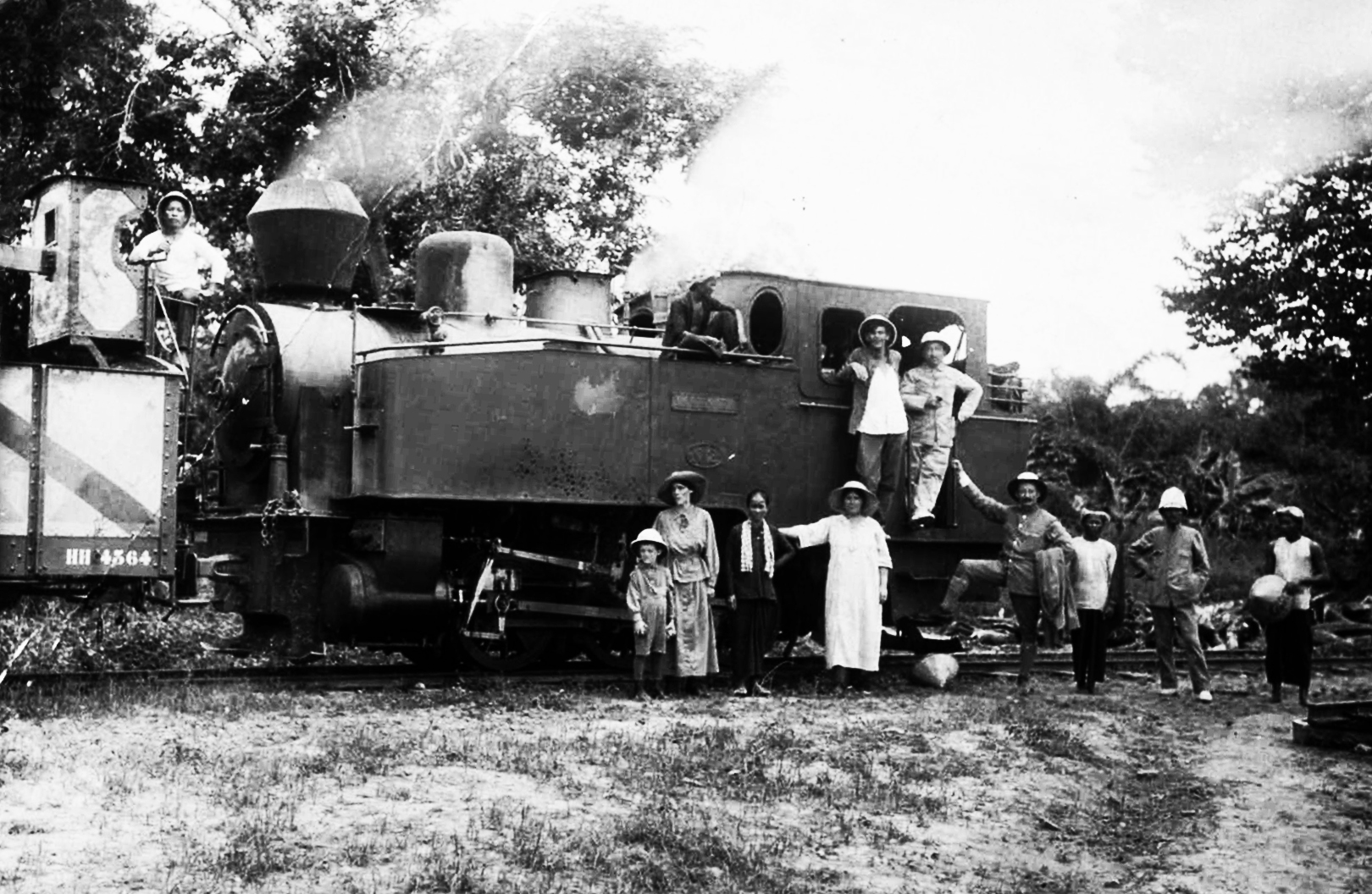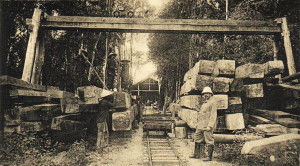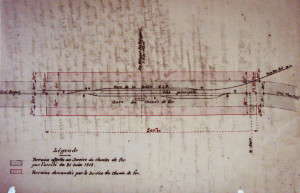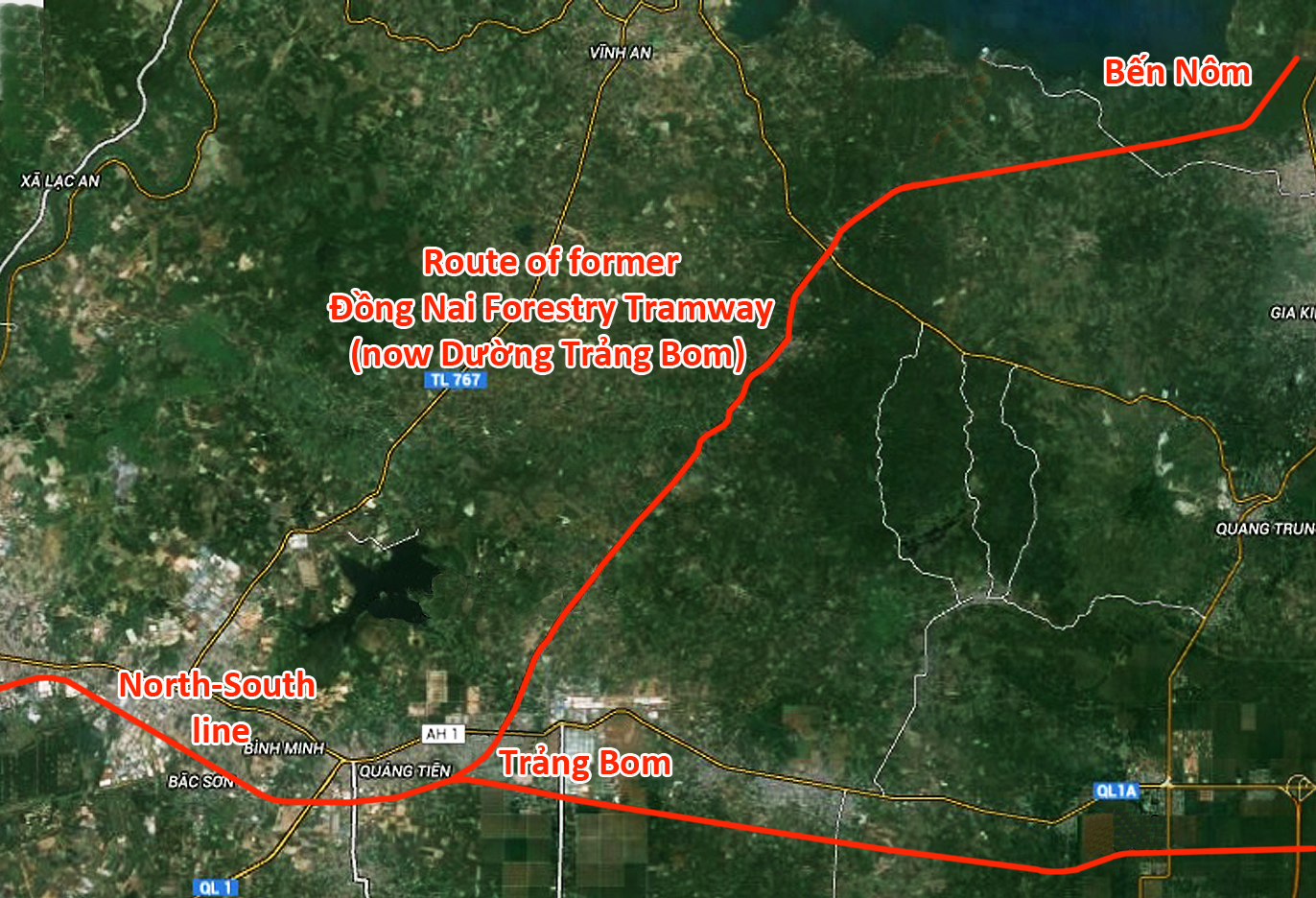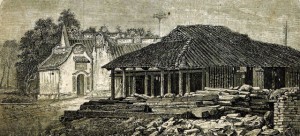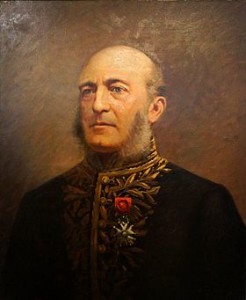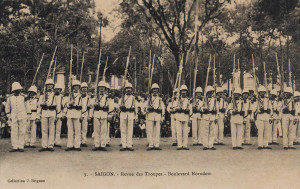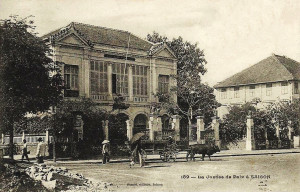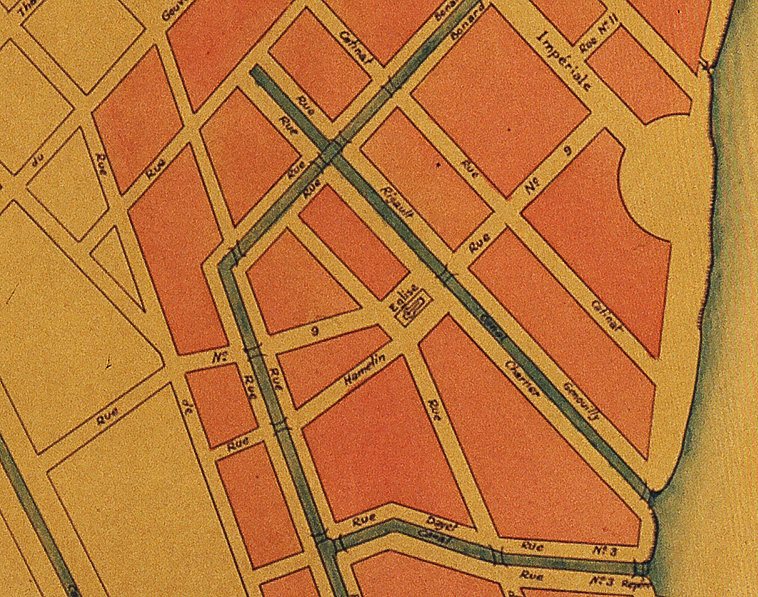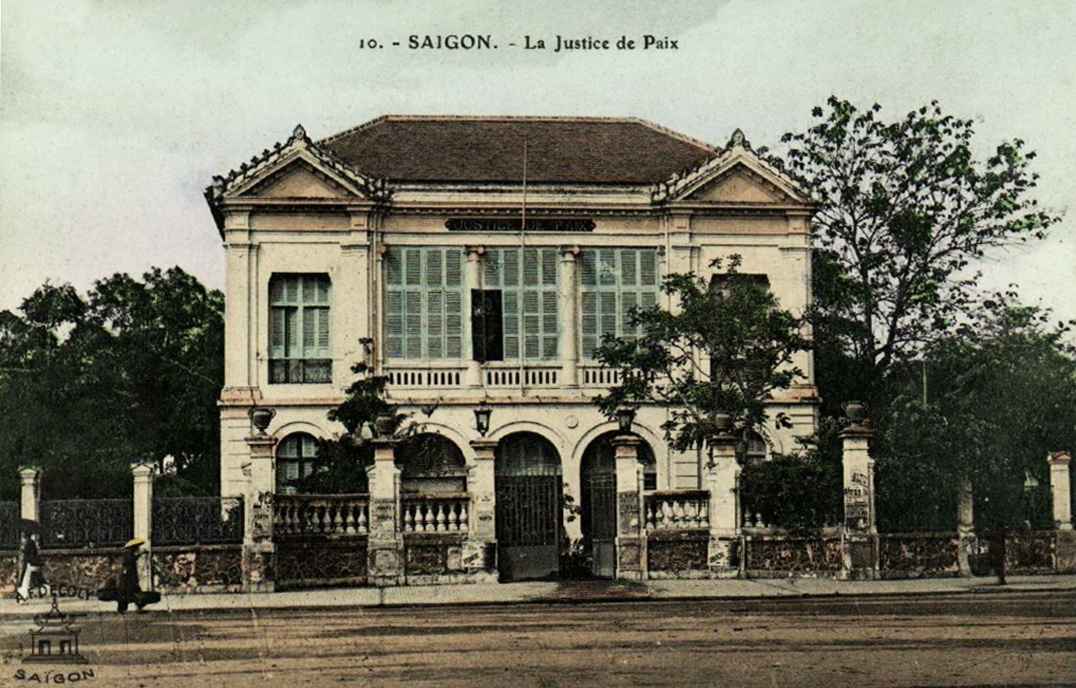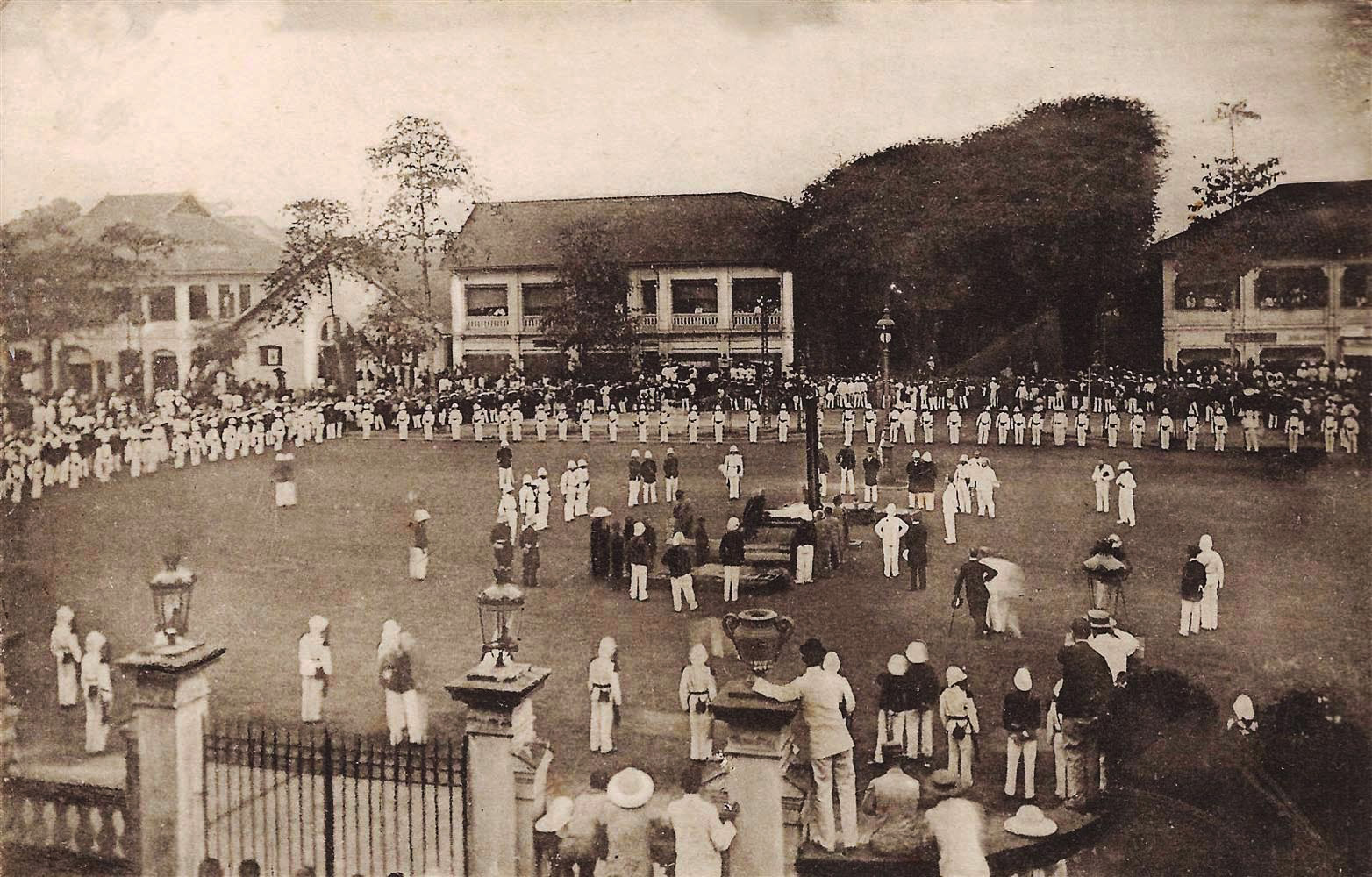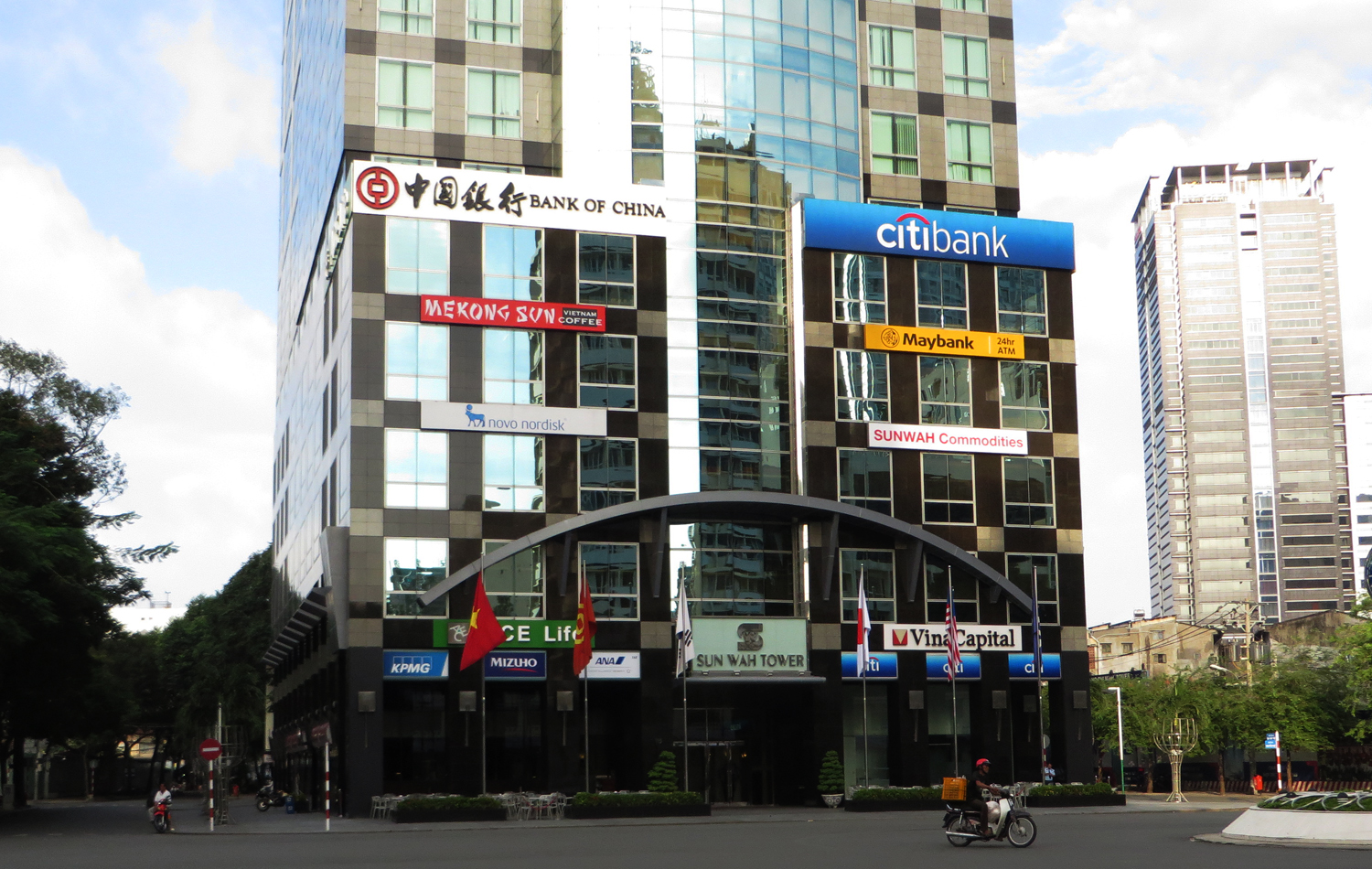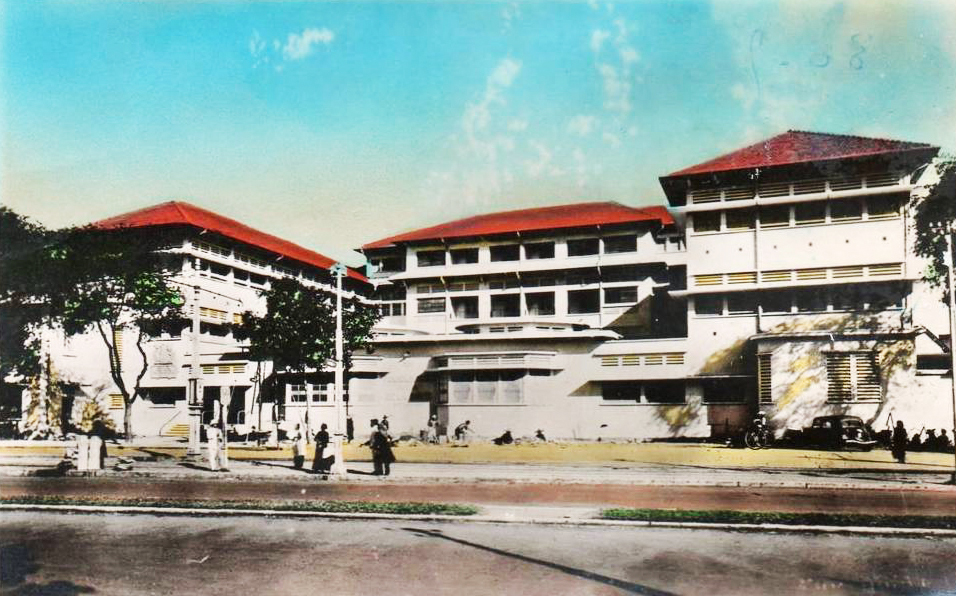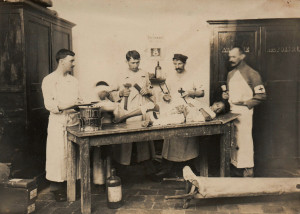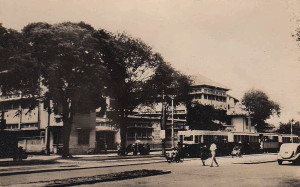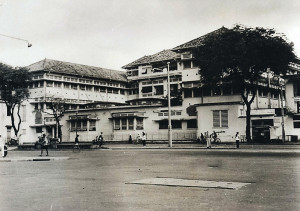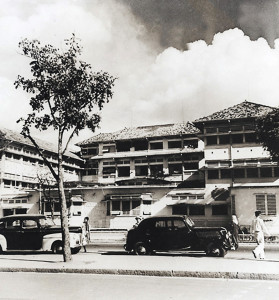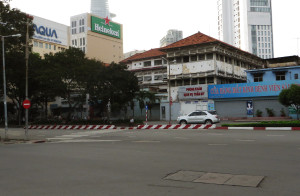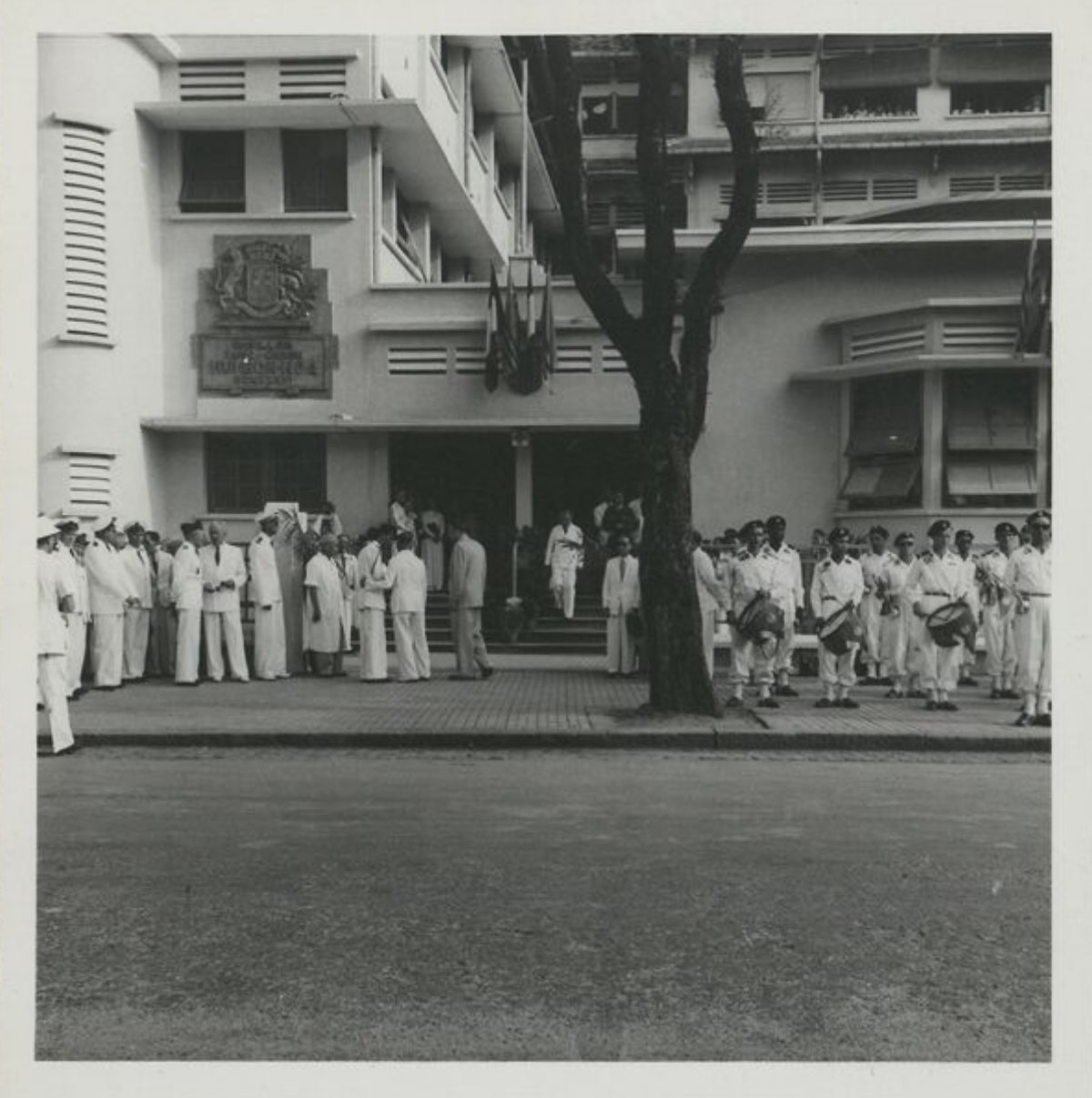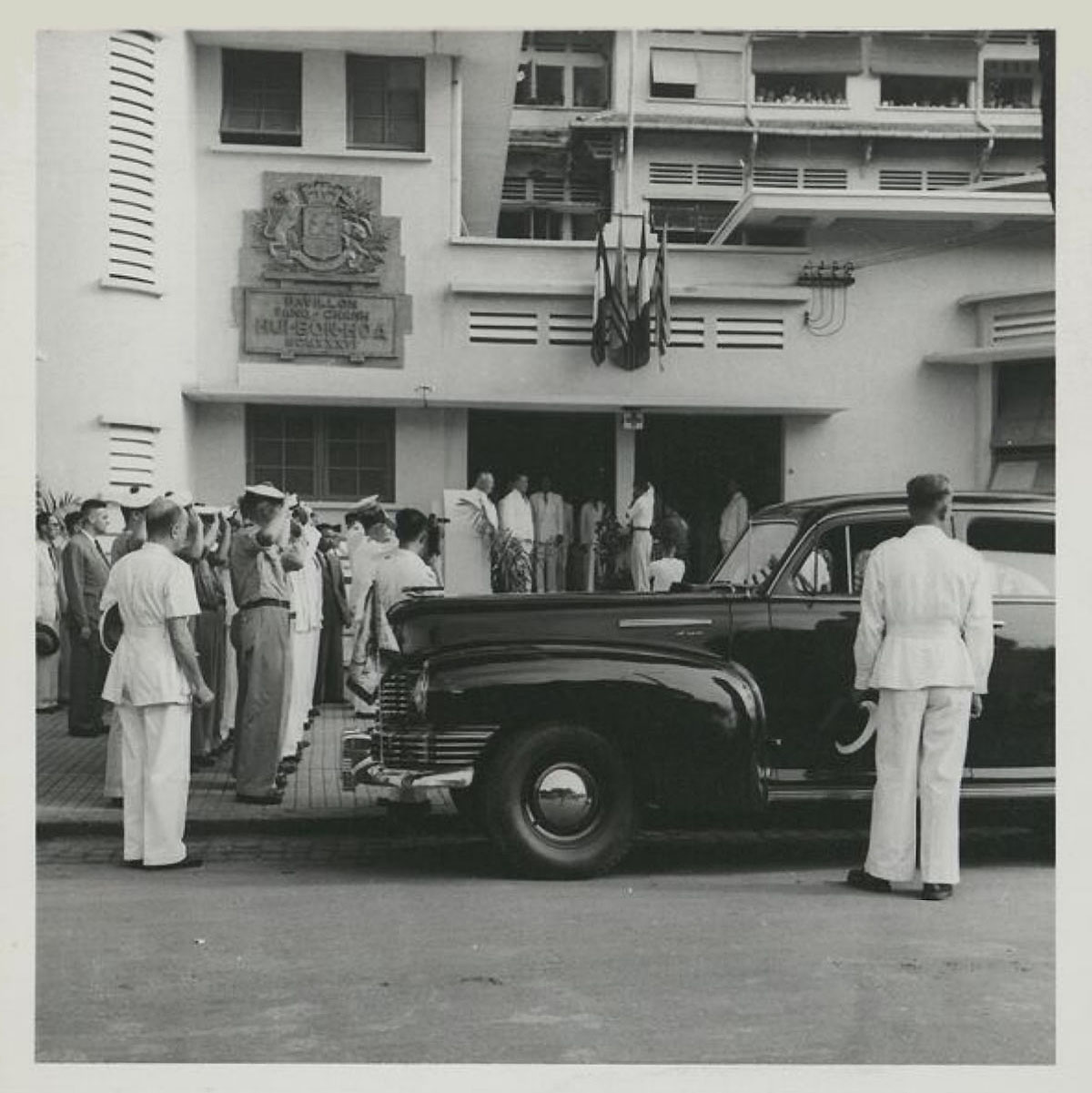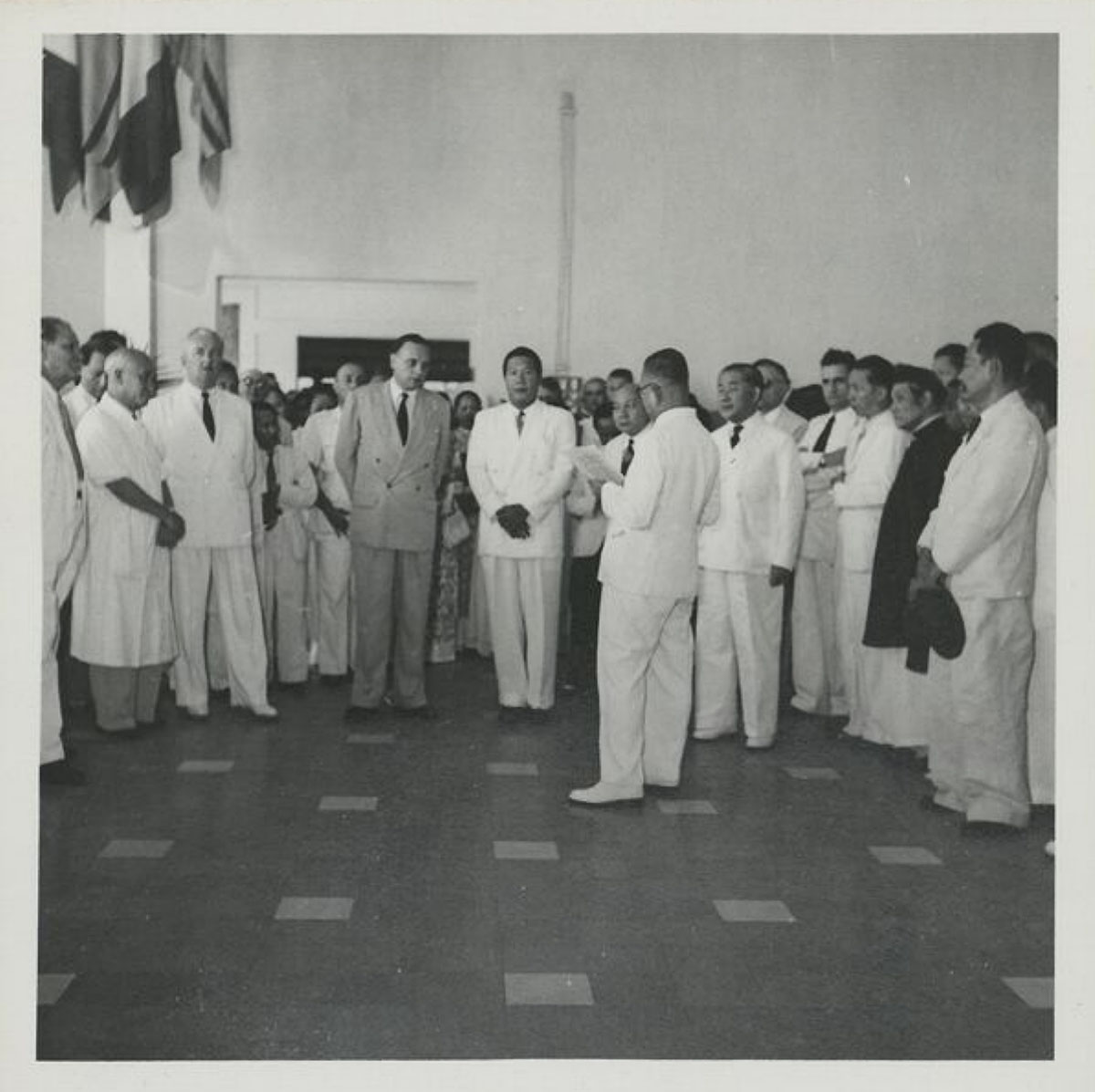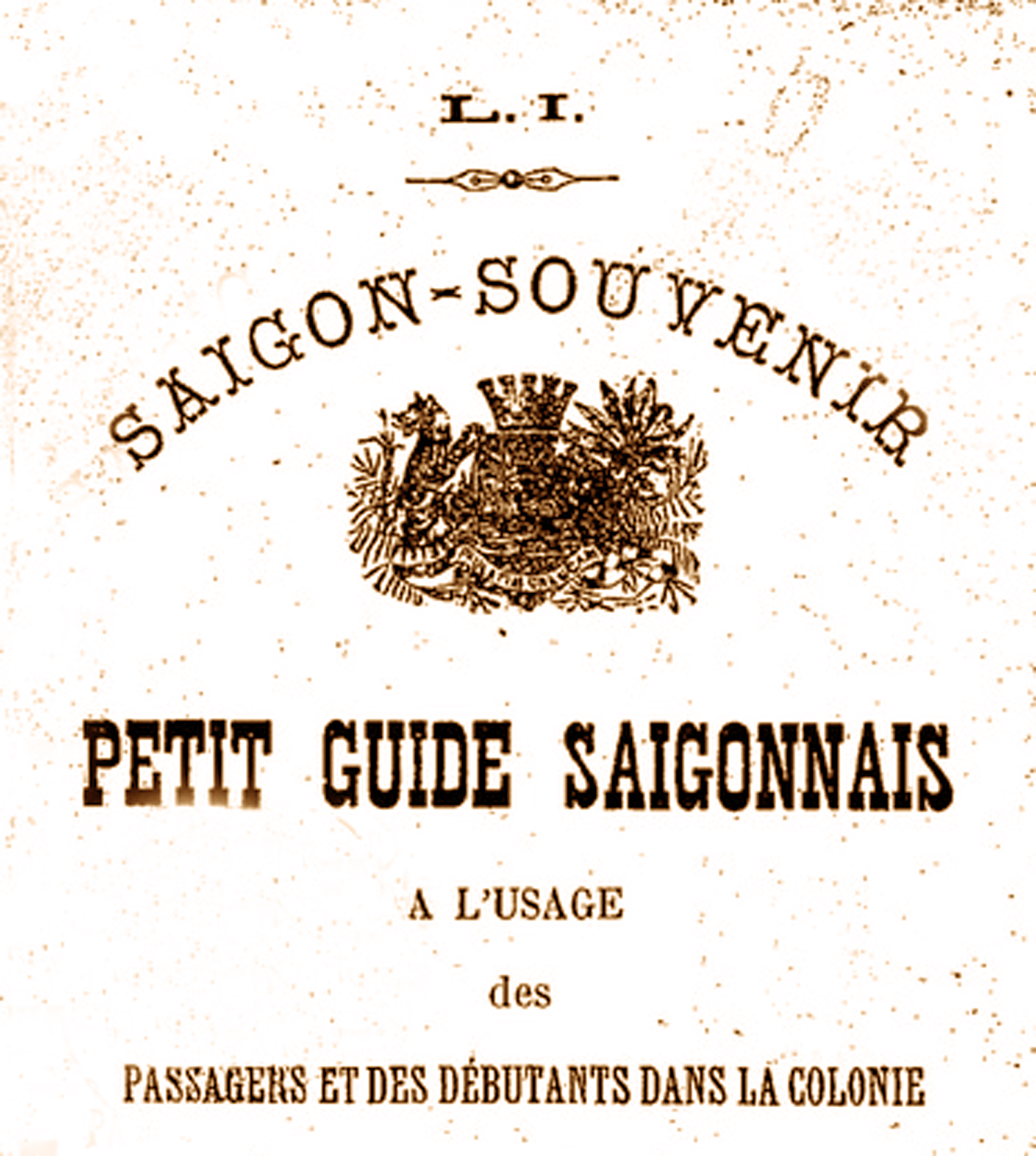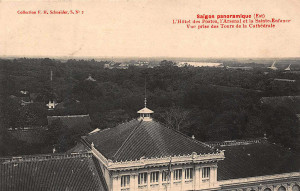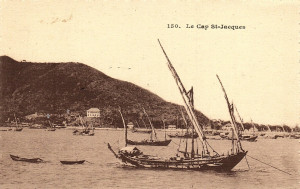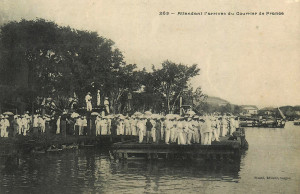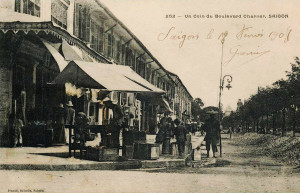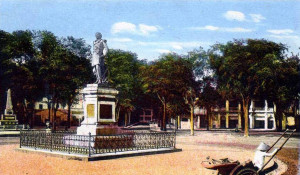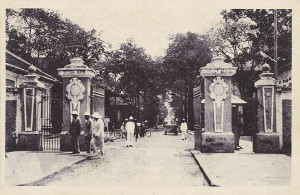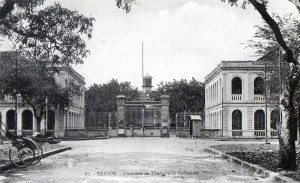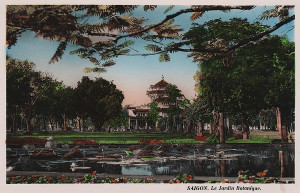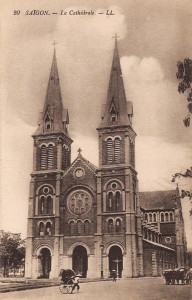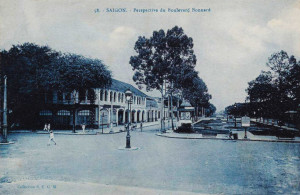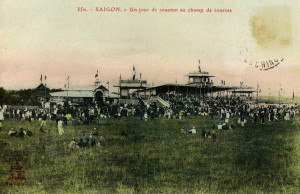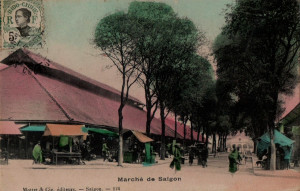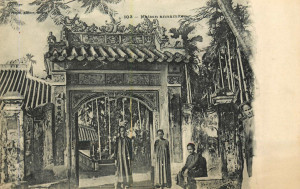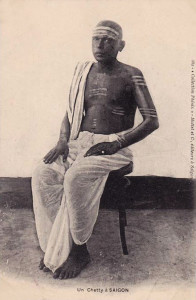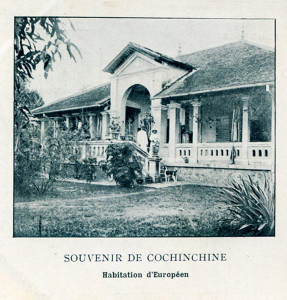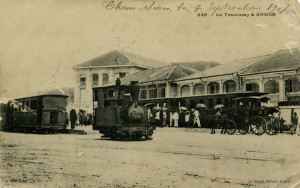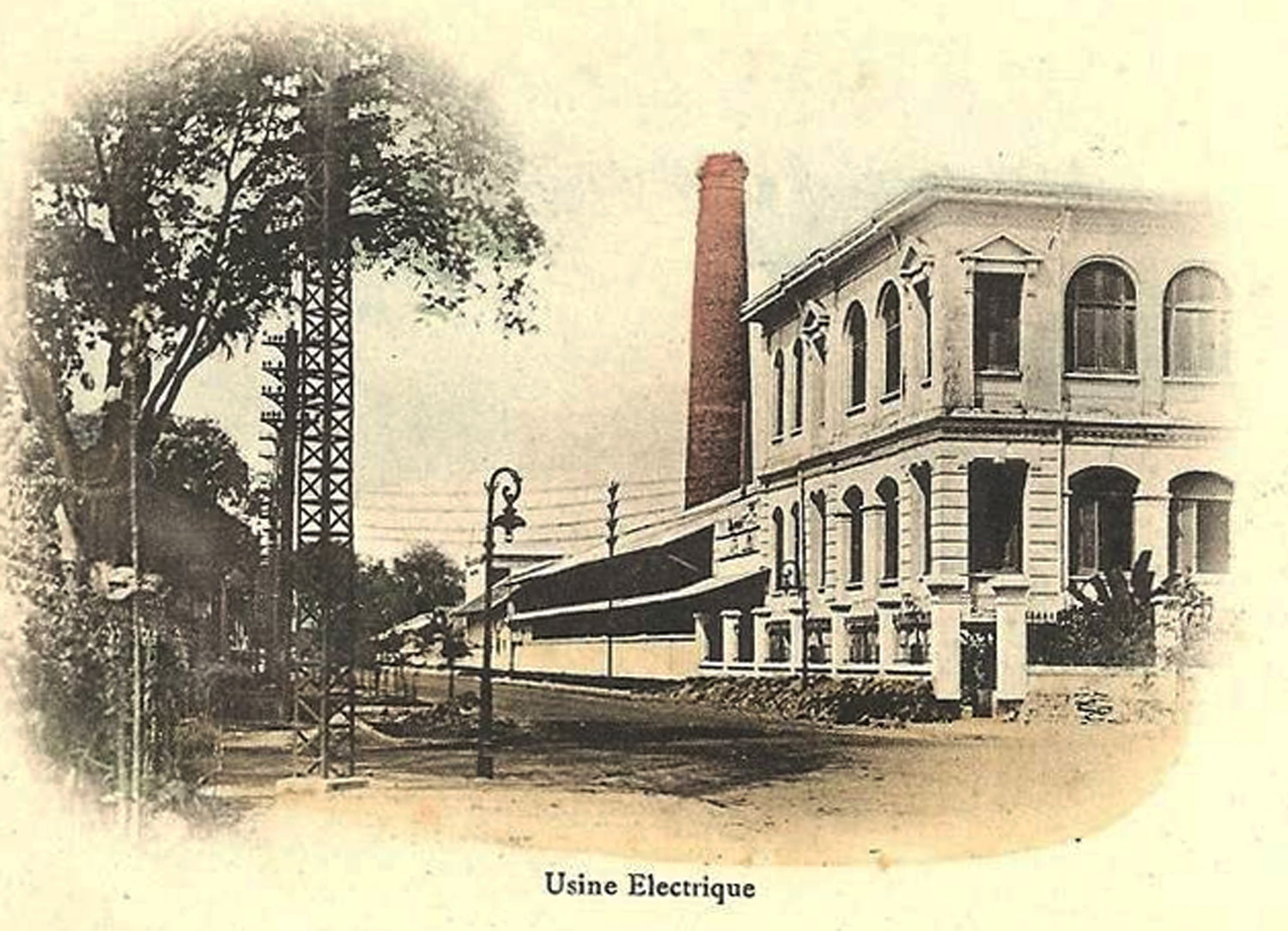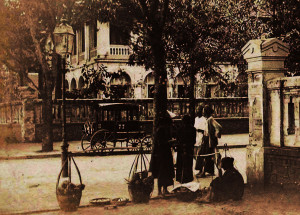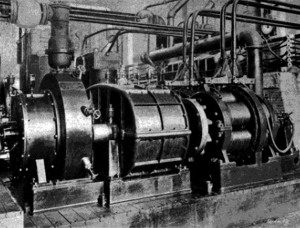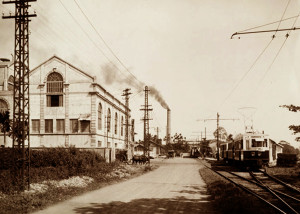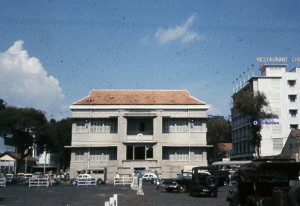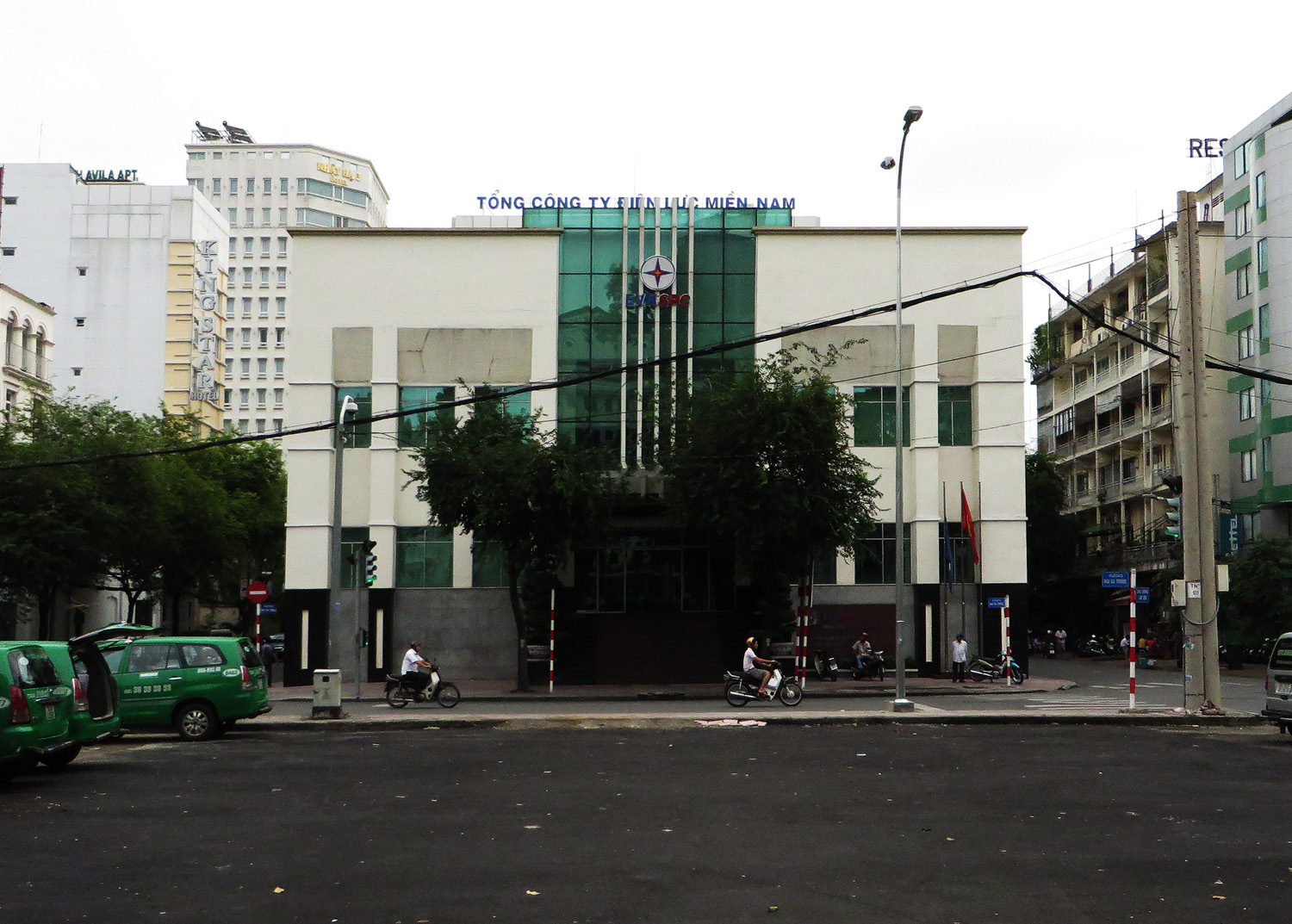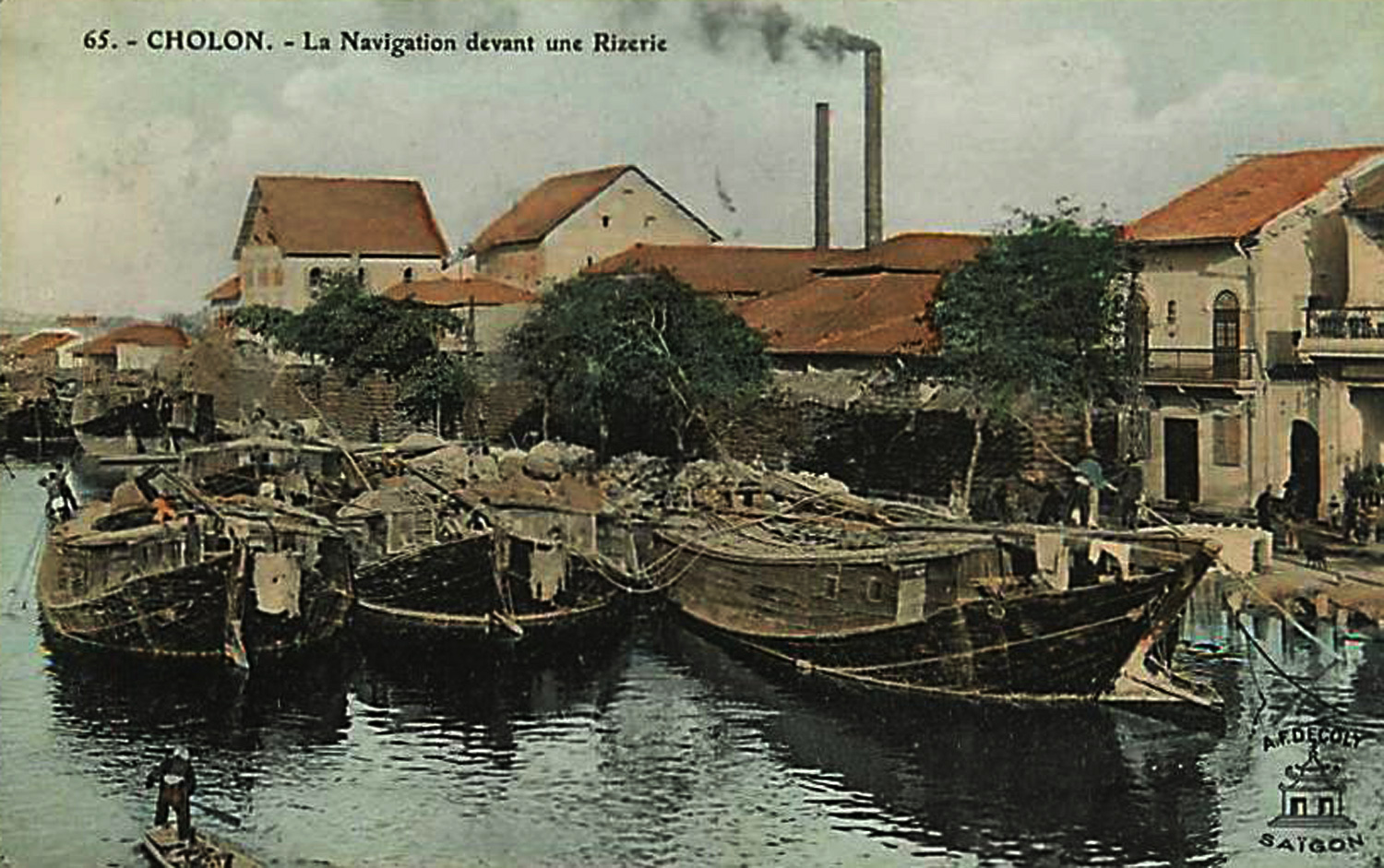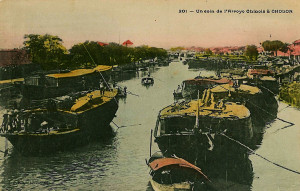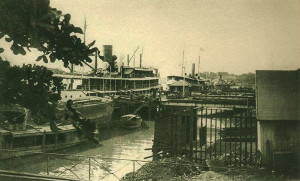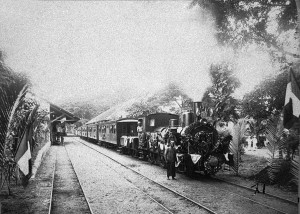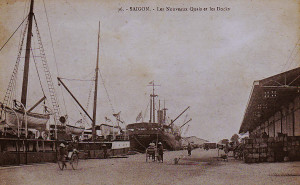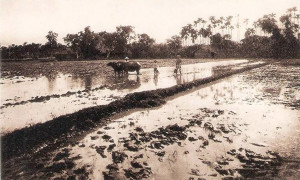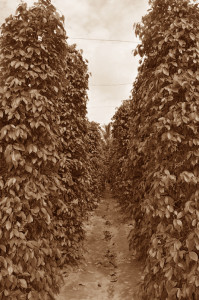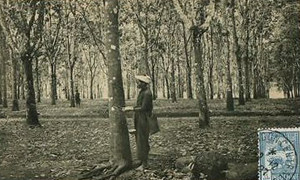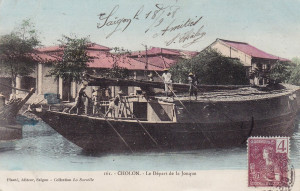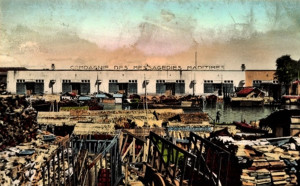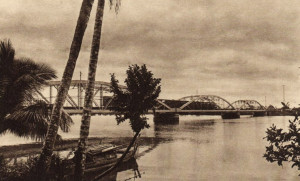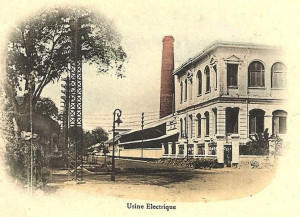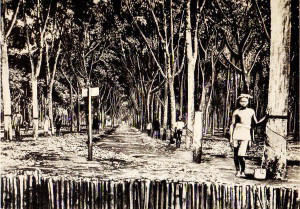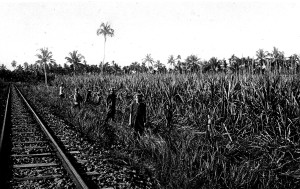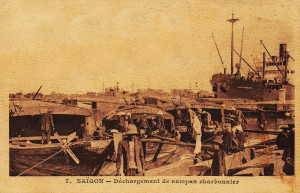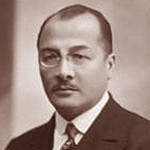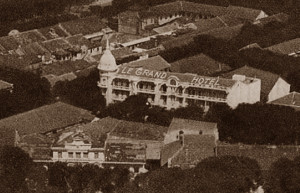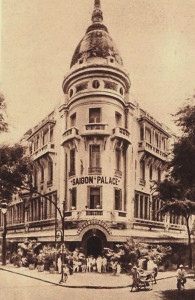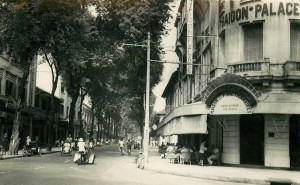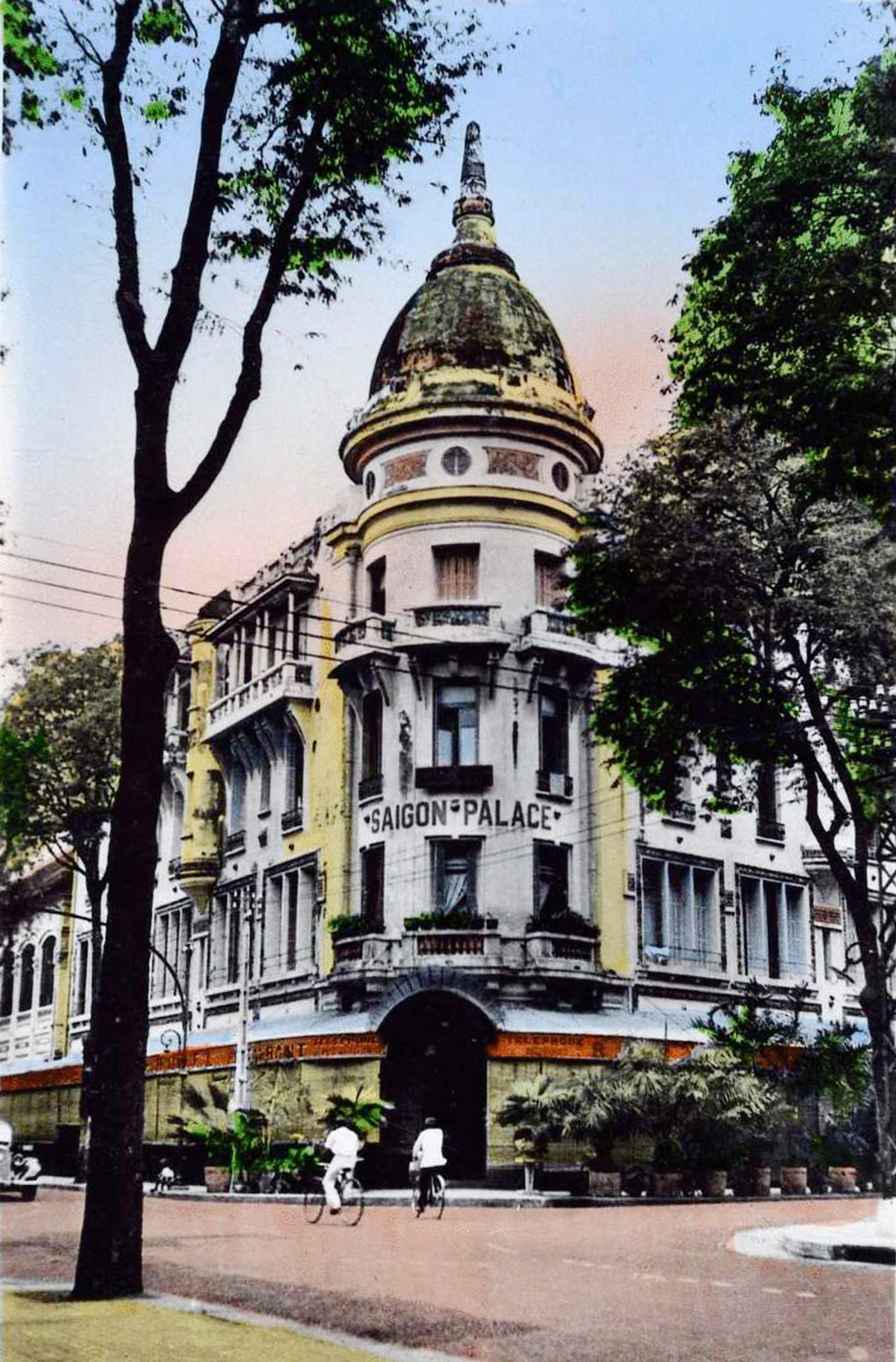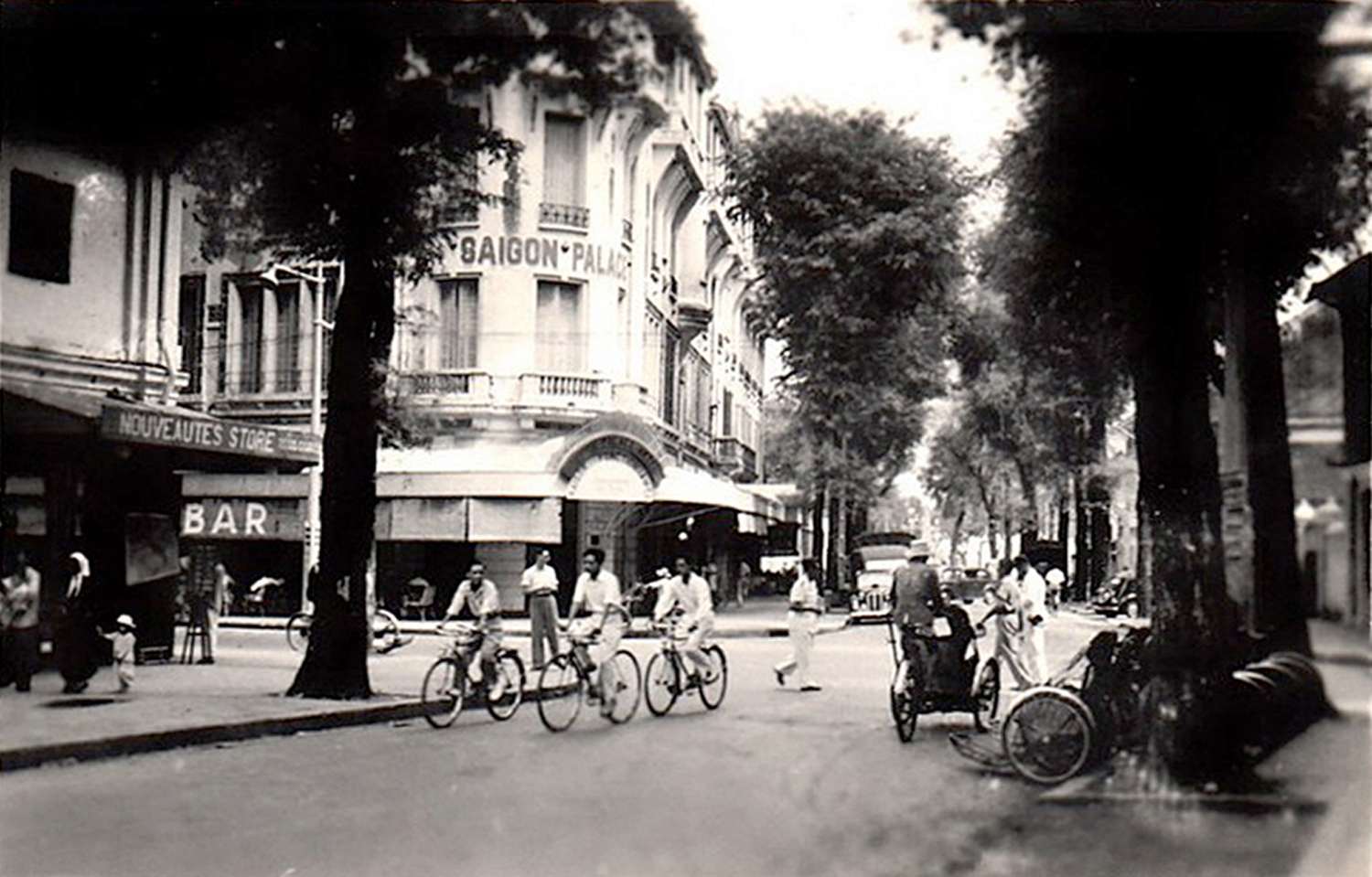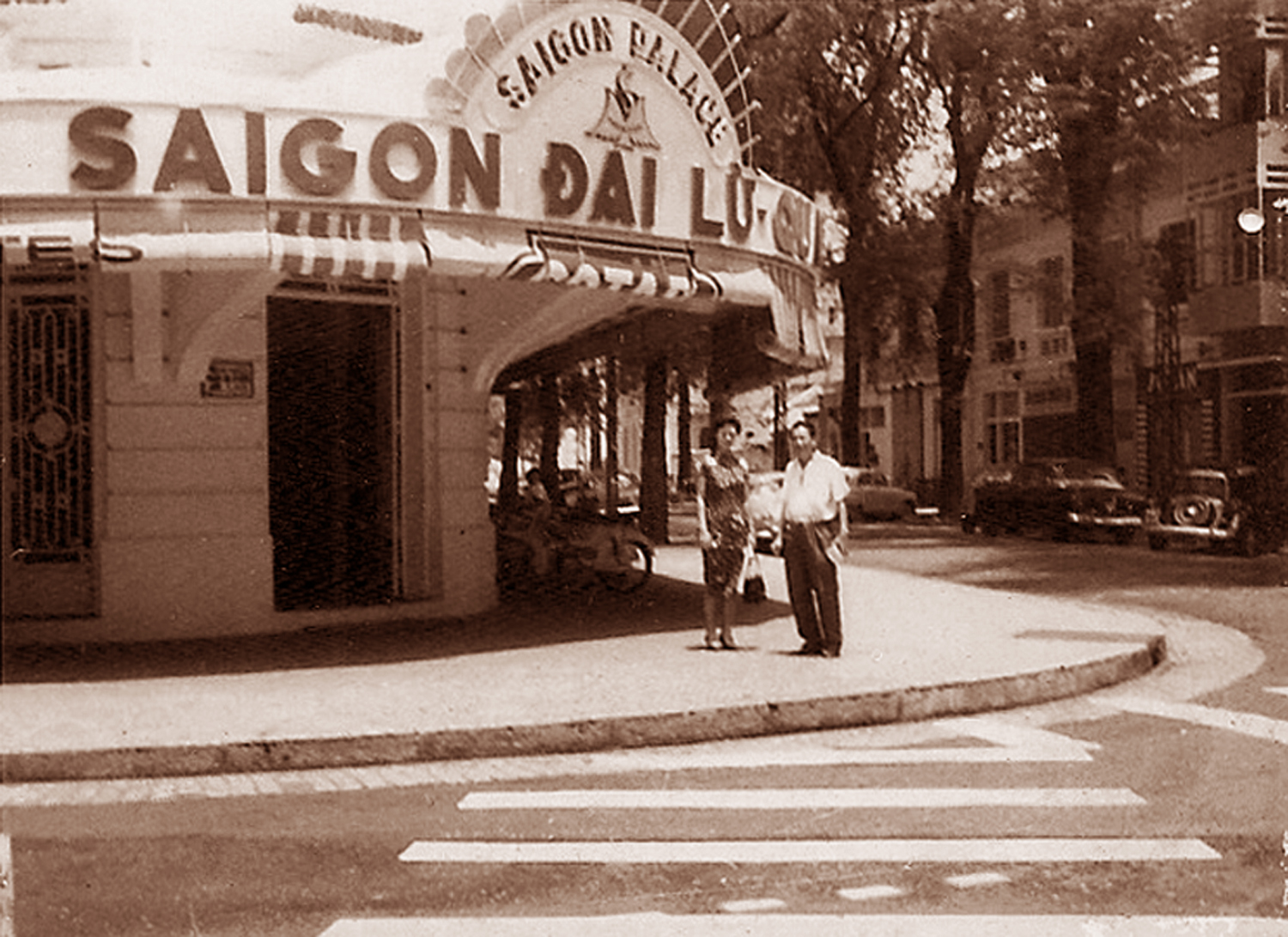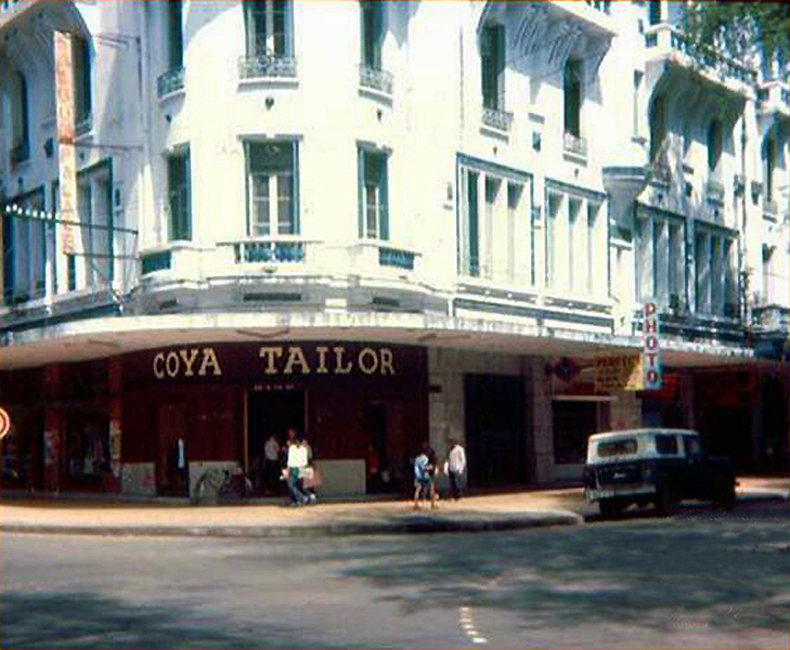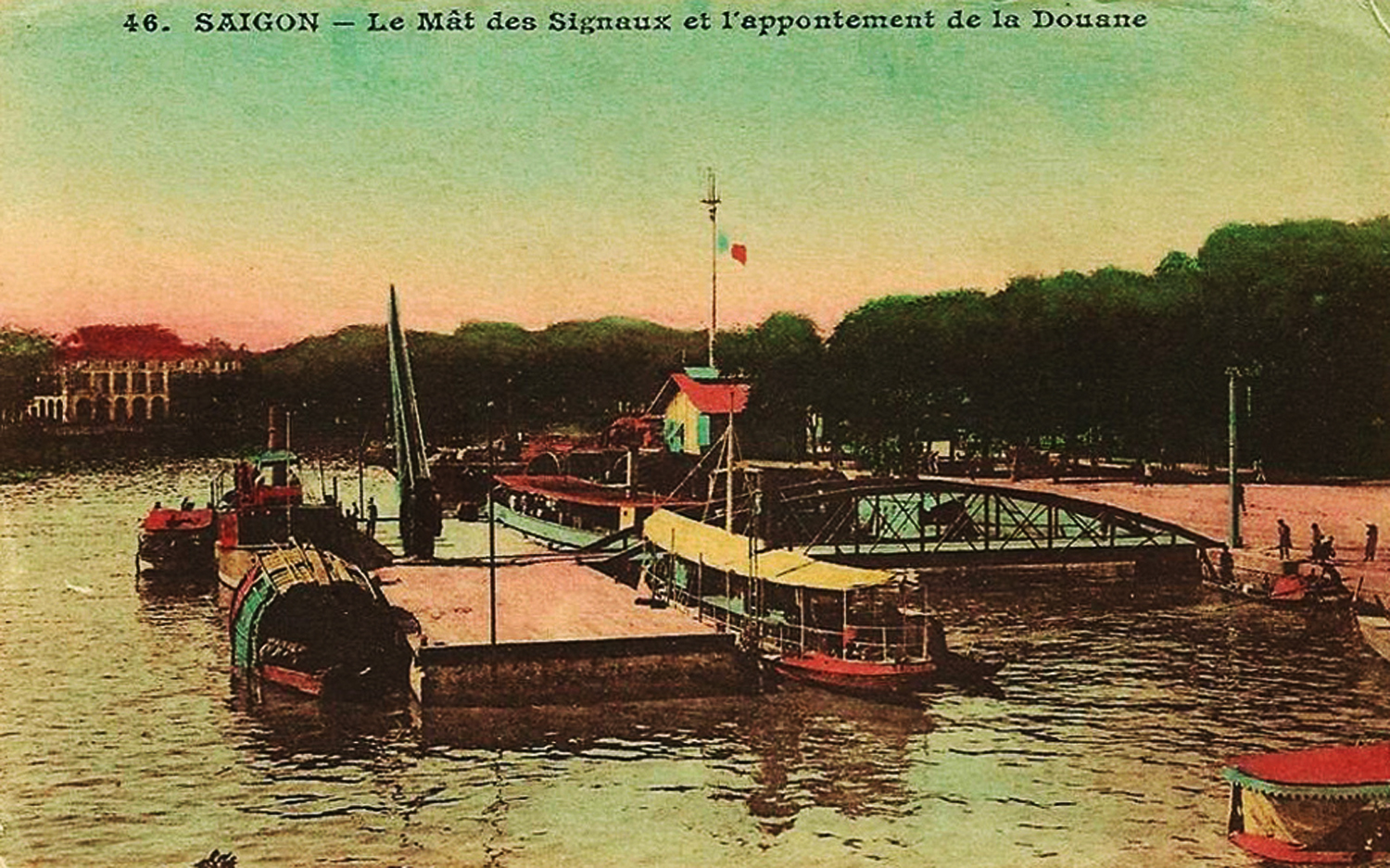
French travel writer Claudius Madrolle (b 1870) was a Far East specialist and his guidebook Vers Angkor. Saïgon. Phnom-penh (Towards Angkor. Saigon. Phnom Penh (Hachette, 1913) became a best-seller. Here is his chapter on Saigon and Cholon.
Travelling to Saigon
All steamships travelling to Saigon stop at Cap Saint-Jacques. From here you can telegraph to reserve a hotel room in Saigon.

Cap Saint-Jacques
If you are coming from the south, you will pass the Poulo Condore Islands (penitentiary, lighthouse at an elevation of 212m), which also have a telegraph service connecting with the neighbouring stations of the Bassac and the Cap.
Steamships arriving from the north will be in contact with the coast of Annam as soon as they reach Port Dayot [near Nha Trang] and may telegraph via the post of Padaran [Mũi Dinh].
Cap Saint-Jacques is a seaside resort and an important military centre surrounded by fortifications which overlook the harbour. Here, steamships stop in the shelter of a promontory (Ganh-rai or “Cap des Loutres,” meaning “Otter Cape”), on which there is nothing but a lighthouse.
After a local pilot has boarded, the vessel enters the Dong-Nai River via its mouth, the Loi-Rap, passing on its right the sheltered bays of Can-Gio and Dong-Tranh.
On the left is the entrance from the sea to the Cua Tieu, the easternmost mouth of the Mekong River. Foreign steamships entering this waterway en route for Phnom Penh must stop here and report to the Ben-Chua customs post.
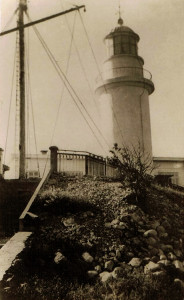
The lighthouse at Cap Saint-Jacques
The lower section of the Dong Nai River seems completely deserted, and its banks, lined with mangrove trees, show few signs of habitation. But many large rivers criss-cross the vast deltaic plain which the Annamites have been colonising for 300 years, repressing or driving out the Malays on one hand and the Khmers on the other.
On the right bank, one sees the district of Go-Cong and the wide mouth of the Grand Vaico, the two upper arms of which, emanating from Cambodia, pass through the districts of Tay-Ninh and Tan-An. And on the left bank, the lowlands of the Dong-Nai delta, intersected by a large number of the river’s tributaries, several of which are very deep. Further up the river, the ship passes the heights of the Tan-Luong plateau.
Suddenly, at a bend in the river, the slender towers of the Saigon Cathedral come into view. However, since at this point the river takes a number of capricious turns, it is sometimes on the left and sometimes on the right that we see this landmark from the upper deck of our ship.
After passing the Petrol Depot at Nha-Be, we leave the Dong-Nai River (which continues northward to Bien-Hoa) and enter the Saigon River.
The fleet of the Customs Directorate is moored at the Fort du Sud, an ancient Annamite fortress. On its exterior sloping walls are located the gun battery which is used to salute the fleet.
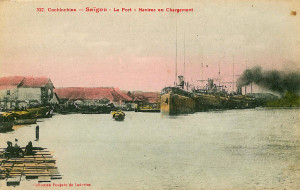
Saigon port in the early 20th century
Next, we pass the small parish church of Xom-Chieu, the entrance to the Canal de Dérivation (By-pass canal) which connects with the arroyo-Chinois [Bến Nghé creek], and the Tam-Hai wharf where most of the steamships are at anchor.
We arrive at the headquarters of the Compagnie Messageries maritimes, built in 1862, and further upstream we see a few warships anchored in front of the Naval Arsenal.
Encountering the Annamite people for the first time, the visitor is very surprised at first not to find a marked difference between the silhouettes of Annamite men and Annamite women, because both sexes wear almost exactly the same clothing (a long tunic covering the pants) and hair wound in a kind of bun. However, this astonishment is of short duration, for it is easy to recognise from the gait and face whether you are looking at a man or a woman.
Visit customs. Take a carriage or pousse-pousse to your hotel.
Hotels
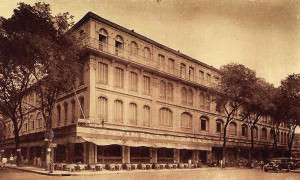
The Grand Hotel Continental
Continental Palace Hôtel, rue Catinat, near the Theatre (90 beds). Languages spoken: French, English, German, etc. Each room has a shower. Single room and board from 7 to 11 piastres, twin room and board from 12 to 20 piastres, apartment 20 piastres, service and lighting included; fan 1 piastre; breakfast 75 cents; lunch 11am-1pm including wine 2 piastres; dinner 7pm-8.30pm 2.50 piastres, and on the terrace 3 piastres. Arrangements for extended stays and families: full board, garden room from 5 piastres; 3rd floor room overlooking street from 6 piastres.; 2nd floor room overlooking street from 7.50 piastres (12 piastres for two persons).
Hôtel des Nations (Pancrazi), boulevard Bonard, single room and meals from 5 piastres; twin room and meals 8 piastres
Hôtel de l’Univers (Mottet), rue Turc, room and meals from 5 to 9 piastres per day; from 80 to 200 piastres per month long stay.
Cafés
In addition to those of the above hotels, the Café de la Musique and the Café de la Terrasse, both located near the Theatre.
Transportation
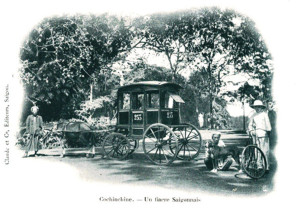
A “Malabar”
Horse-drawn carriages: There are two types of horse-drawn carriage. The first has two horses and costs 25 cents per single journey, 50 cents per hour and 40 cents for subsequent hours. From Saigon to Cholon, this type of carriage costs 70 cents per single journey and 1.30 piastres for a return journey with a one hour stopover. And for the “Tour de l’Inspection,” it costs 90 cents for a simple round trip and 1.20 piastres with an additional half-hour stop. The second type, a one-horse carriage known as the “Malabar,” costs 15 cents per single journey, 30 cents per hour and 25 cents for subsequent hours. From Saigon to Cholon, this type of carriage costs 50 cents per single journey and 90 cents for a return journey with a one hour stopover. And for the “Tour de l’Inspection,” it costs 60 cents for a simple round trip and 70 cents with an additional half-hour stop.
Chauffeur-driven carriages: 1.50 piastres per hour.
Automobiles: For small runs, we take “auto-taxis” with meters. For day trips, depending on distance, they cost from 25 to 50 piastres – contact Ippolito, boulevard Charner, or Mignot, 19 rue d’Espagne.
Pousse-pousse: With rubber tyres: 10 cents per single journey, 25 cents per hour and 20 cents for subsequent hours. From Saigon to Cholon, 40 cents per single journey, 80 cents for a return journey with a one hour stopover. And for the “Tour de l’Inspection,” 45 cents for a simple round trip and 55 cents with an additional half-hour stop.
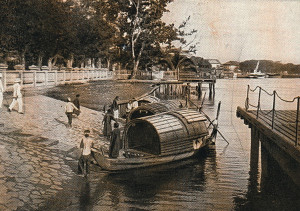
Sampans for hire in the harbour
Voitures ordinaires: 8 cents per single journey, 20 cents per hour.
Sampans: Available in the harbour, from 8 to 10 cents per single journey, from 10 to 15 piastres per hour, 1.50 piastres per day and 1 piastre for subsequent days.
Post Office
Near the Cathedral; long-range wireless telegraphy connecting with the stations at Cap Saint-Jacques, Hanoi and Kouang-Tcheouwan [Guǎngzhōuwān or Guǎngzhōu Bay].
Banks
Banque de l’Indo-Chine, 22 quai de l’arroyo-Chinois; Hongkong & Shanghai Bank, 9 quai de l’arroyo-Chinois, Chartered Bank of India Australia and China, 1 rue d’Adran.
Clubs
Cercle de l’Union, place du Théâtre; Cercle Colonial, rue Catinat; Cercle Sportif, rue de Lagrandière – lawn tennis, shooting, cycling and motorcycling, fencing tournaments.
Tourism information
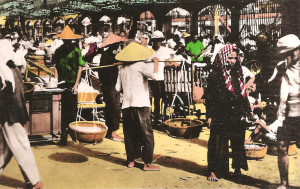
A market scene
The Syndicat d’Initiative du Sud Indochinois (Southern Indochina Tourism Information Office) contributes to the development of tourism in southern Annam, Cochinchina and in Cambodia.
Concerts, theatre
Military band music: Monday at the Cercle militaire; Wednesday on boulevard Charner [Lê Lợi]; Friday at the Military Hospital; Sunday at the Botanical and Zoological Gardens.
Theatre: Performances of comic opera, operetta, comedy-vaudeville, from October through to April, Tuesdays, Thursdays, Saturdays and Sundays. Prices: Upper Boxes, Lower Boxes and Front Stalls 5 Francs, Middle Stalls 4 Francs, Rear Stalls 3 Francs, Gallery 2 Francs.
Consulates
Great Britain, Germany.
Bookstores

A corner of rue Catinat in the early 20th century
Rousseau (L Royer), 39 rue Catinat; C Ardin, 74 rue Catinat; Portal, 125 rue Catinat; F H Schneider, 2 rue Kerlan.
Tourists may purchase a 1:200.000 road map of Cochinchina, prepared in 1912 by M. Lebret on the orders of Governor Destenay, or 1:100.000 maps (price 1.33 piastres) issued by the Indochina Geographic Service.
Scientific and educational institutions
The Société des Études Indochinoises (Indochina Studies Society): 16 rue de Lagrandière; museum open daily except Monday, 8am-11am and 3pm-6pm; samples and casts of Khmer and Cham art; coin collections from the Far East; library open to visitors.
Government Library: 27 rue de Lagrandière; 8am-11am and 2.30pm-5pm, 12,000 volumes.
Institut Pasteur: rue Pellerin, an annex to that of Nha Trang.
Colleges for the study of French language; Franco-Annamite schools where native pupils are taught transcription of their own language in the Latin alphabet, which, in this form, is improperly called quoc-ngu, meaning “national language;” and private schools which sometimes teach Chinese ideographic characters for future members of the literati.
Tramways
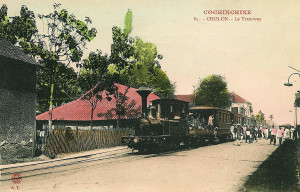
The Saigon-Cholon “High Road” steam tramway
Saigon-Cholon “High Road” steam tramway: 5.1km, stops at rue Mac-Mahon in Saigon, Cho-Dùi (church built in 1902), Cholon.
Saigon-Cholon “Low Road” electric tramway: 6.3km, stops at Cau-Ong-Lanh, Cau-Kho, Cho-Quan (4km), Rizerie, Cholon (Binh-Tay).
Saigon-Hoc Mon steam tramway: 20.2km, price 20 cents, departures every hour, stops at Arsenal, Citadelle (3.2km), Dakao (4.5km, with 1km branch line to Tan-Dinh), Gia-Dinh, Pagode de Xom-Ga (7.2km), Go-Vap (with additional 10km branch line to Lai-Thieu on the Saigon River, 1 hour journey, price 30 cents), Xom-Thuoc, Hanh-Thong-Tay, An-Hôi, Cho-Moi, Quan-Tre, Trung-Chanh, Hoc-Mon.
Railways
Saigon-My Tho railway: 70.8km, via Cholon and Tan-An.
Saigon-Nha-Trang railway: 408km, via Bien-Hoa (33km), Phan-Thiet (190km), Phan-Rang (320km, with 37km branch line to Xom-Gon, and projected 60km branch line to Da-Lat on the Langbian Plateau) and Bang-Hoi (Cam-Ranh, 370km).
Places of interest
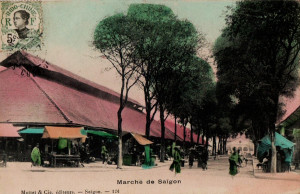
The old Saigon Market on boulevard Charner
The rue Catinat; Museum of the Société des Études indochinoises, Notre Dame Cathedral, the Palace of the Governor General, the Jardin de Ville (City Park), the Botanical and Zoological Gardens, the Naval Arsenal, the Chinese Quarter.
Visit the market in the early morning; take the late afternoon “Tour de l’Inspection” from 4pm to 7pm; and (in wintertime) spend an evening at the Theatre.
Excursions
For those with only a few hours: visit either the Botanical and Zoological Gardens or the Chinese city of Cholon.
For those with a full day: The beautiful roads of eastern Cochinchina are ideal for those wishing to take interesting excursions by automobile. Destinations include: Cap Saint-Jacques (129km, hotel) via Bien-Hoa and Ba-Ria; Tay-Ninh (101km, guest house) (for these two destinations one can also use the postal service automobile); Thu-Dau-Mot (29km); Chon-Thanh and its forests (74km); Hon-Quan and its forests, hunting, plantations and ethnic minorities (99km, villa for rent, take food); the superb Tri-An Waterfall (55km, villa for rent, take food) via Bien-Hoa; and the Tombs of the Royal Family near Go-Cong (56km) via Cholon and Can-Giuoc (22km).
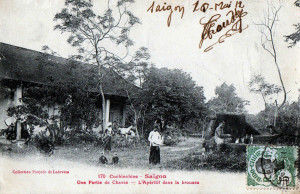
An apertif in the bush before a hunt resumes
The hunting areas of La-Nga and Dji-Rinh are ranked among the most remarkable in the world. However, if the tourist goes into the forest, he must be very careful, be armed and have a good guide. The Malay aboriginal is very sweet natured, but one must always be on guard against the attacks of wild beasts, such as tigers, panthers, rhinoceroses, elephants, bears, wild buffalo and wild boar. It is easier to hunt wild hens, pheasants, partridges, quails, peacocks, hares, deer. There are also monkeys and pangolins. Beware of reptiles such as cobra, python, green pit vipers, coral snakes and boa constrictors.
Rubber plantations growing Hevea brasiliensis, Ficus elastica and Gutta-percha are easy to visit – contact the companies directly. Some, like Xa-Trach and Loc-Ninh, are located on terre grise (grey earth) territory in the province of Gia Dinh, while others, like Suzannah and An-Loc, are situated on terre rouge (red earth) territory in the north and east of Cochinchina. One reaches the latter by train.
Saigon
Saigon is located at latitude 10°47’24” N and 104°18’26” E on the Ben-Nghe or Saigon river, 75km from Cap Saint-Jacques. The population of Saigon at the end of 1883 was 13,348 souls, including 913 French, 53 other Europeans, 5,595 Chinese and 6,246 Annamites. By 1911 it was 58,998 inhabitants, including 8,364. French, 157 other Europeans, 16,500 Chinese and 32,500 Annamites.
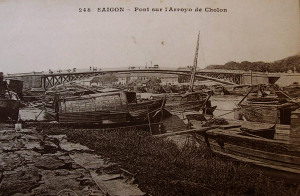
The pont des Messageries-maritimes
To local people, Saigon is in fact the official name of the neighbouring “Big Market,” commonly called Cholon. The area occupied by the government, meanwhile, was originally known by the administrative name Phan-Yen or Gia-Dinh, while the commercial area adjacent to the river retained its old popular names Ben-Nghe or Ben-Thanh (the latter meaning “Citadel of the firewood”), names which are still in use today. The error committed by foreigners in naming their capital as Saigon has begun to be accepted by the Annamites. Meanwhile, the Chinese, who once employed the characters Tch’ai-Koun – meaning “firewood” – now write Si-Kong, meaning “Tribute of the west.”
The upper part of the city was inhabited in prehistoric times, as evidenced by weapons and polished stone tools found during excavations carried out during construction of the Cathedral. At the time of the Angkorian empire, this sparsely-inhabited land was Khmer territory. In the 17th century, the Annamites came to trade on the shores of Dong-Nai river and on “the plain of the Deer,” setting up a Customs House in Ben-Nghe (Saigon) which was conferred on them in 1623 by the Cambodian king. In 1672, the Nguyen princes of Upper Cochinchina (Hue), intruding bit by bit in the affairs of lower Cambodia, installed a Cambodian Vice King at Ben-Nghe, but replaced him in 1699 with a high Annamite official with the title Kinh-Luoc.
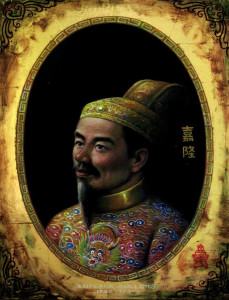
Lord Nguyễn Phúc Ánh, later King Gia Long
At this time, Ben-Nghe was the capital of the General Government of Gia-Dinh (Lower Cochinchina), the seat of the tinh (province) of Phan-Tran and that of the huyen (district) of Tan-Binh. In 1773, the extent of the walled city was doubled in distance following the construction of an earthen wall measuring 15 li in length. However, this did not prevent the city from being occupied four times by the troops of the Tay-Son.
In 1789, the Nguyen army definitively recaptured the walled city, then called Binh-Duong-Huyen. After peace was restored, a new administrative organisation was created.
In 1808 Ben-Nghe (Saigon), capital of Gia-Dinh, became the seat of the tinh of Phan-Tran, of the phu (prefecture) of Binh Duong and of the huyen of Binh-Tri; this organisation was maintained until the arrival of the French (1859).
The first Citadel was built in 1790 in the Vauban style and the city walls were reinforced in 1808. However, in 1835 these structures were considered too extensive and were demolished. A smaller citadel was built in 1837, and it was this entrenchment which was captured on 17 February 1859 by the French, assisted by a Spanish detachment.
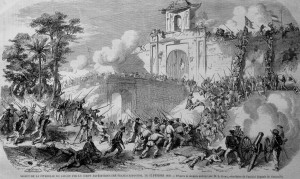
French troops storm the Gia Định Citadel in 1859
Saigon today is one of the residences of the Governor General of Indochina, and the seat of the Lieutenant Governor of Cochinchina, assisted by directors of various administrative services, the Apostolic Vicar of Western Cochinchina, the Commanding General of Troops in Southern Indochina, and a Rear Admiral commanding the Naval Arsenal and the fleet of the colony. It is also the seat of the Court of Appeal, the Court of First Instance, the Commercial Court and the Colonial Council. It has a Chamber of Commerce and a Chamber of Agriculture.
Saigon, together with its suburb of Cholon, forms a conurbation of 240,000 souls; its commercial traffic is worth 350 million francs. This is one of the largest Far Eastern rice markets; it exported 1.1 million tonnes of rice in 1910, 652,000 tonnes in 1911, and 600,000 tons in 1912.
The city extends from the left bank of the arroyo-Chinois [Bến Nghé creek] to the Citadel. Along the Saigon River, docks and European homes have replaced the ancient landings and shops of the former Annamite town of Ben-Nghe, which was connected with the official ville haute (“upper town”) by the street which became rue Catinat.
The western part of the city
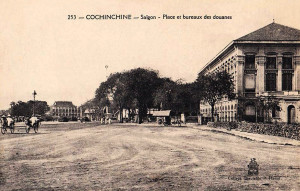
The Customs Directorate
After leaving the Messageries maritimes, one arrives at two bridges over the arroyo-Chinois, which lead from the maritime city to the commercial city.
We see the 30m high Semaphore, and then, on the quay Francis-Garnier [Tôn Đức Thắng], a series of jetties. And at the corner of the rue Krantz [Hàm Nghi], the Customs Directorate.
Behind the Customs Directorate, in the rue des Fleurs, is a Khmer Shivaite temple known as the “Temple of the Phallus” which is revered by a great number of women.
Boulevard Charner measures 40m wide and 1km long and was built over the former Grand Canal, which once permitted junks to bring their goods to the main City Market. That Market is currently situated a short distance along this road, but it will soon be relocated. Beyond it is the Justice of the Peace, built on the site formerly occupied by the Église Sainte-Marie-Immaculée. Here, leading off to the left, is the rue Ohier, an area inhabited by natives of India, with a Brahmanic temple and three Hindu houses belonging to wealthy Chettyars. At the far end of boulevard Charner is the Hôtel de ville (City Hall), built in 1901-1908 and decorated with a belfry.
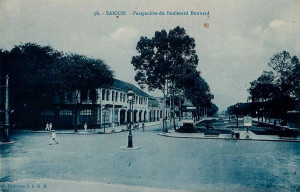
Boulevard Charner, Saigon
The rue Catinat, 20m wide and the oldest street in the city, leads 1,500m from the quayside up to the Cathedral. Situated at the point where it crosses the boulevard Bonard, near the statue of Francis Garnier (1839-1873), is the Municipal Theatre. Built in 1899 to the plans of Ferré, it can hold up to 800 spectators. Around it, on the square, are the Continental Hôtel and several large cafes. Nearby are the offices of the main administrative services.
Up on the “plateau” is the Cathedral square, decorated with a statue of Monsignor Pigneau de Béhaine, Bishop of Adrán, which was inaugurated in 1902. The bishop is depicted presenting to the court of Versailles the Prince Canh, son of the future King Gia-Long, to whom he was the ambassador. He holds in his hand the treaty he had just signed with the Count de Montmorin, Minister of Louis XVI.
The Notre-Dame Cathedral was built in Romanesque style between 1877 and 1883 to plans by Bourard. Constructed in red brick on a granite plinth, its two 40m high square towers are topped by iron spires. Close by is the Post Office, its main hall decorated with frescoes.
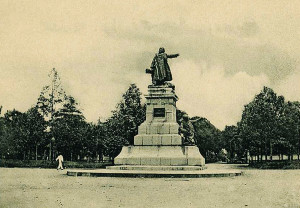
The statue of Gambetta (1838-1882)
Further north, the boulevard Norodom runs from Palace of the Governor General to the Botanical and Zoological Gardens. On this street is the statue of Gambetta (1838-1882) and nearby, on the rue de l’Evêché [Alexandre de Rhodes], the Bishop’s Palace.
The Palace of the Governor General was built in the middle of a beautiful park during the “time of the admirals.” The façade, pierced by large arched windows, measures 80m. It is flanked by two small wings. Access to the ground floor is via a large porch with two gentle ramps. Just inside the main entrance is a vast hall containing a marble stairway. On the right is the office of the Governor, and on the left, the main dining room. Beyond the stairway is the salle des fêtes (events hall), where 600 guests may be accommodated. The upper floor contains civil and military offices and private apartments.
The Jardin de la Ville (City Park) is adjacent to the Palace compound. It contains a bandstand for musical events and a sports fields which hosts football matches every Sunday.
Nearby are the Collège Chasseloup-Laubat; the Service de l’identification judiciaire (Service of Legal Identification), near the Prison; the Palais de Justice [Law Courts]; and the Palace of the Lieutenant Governor of Cochinchina (a former Museum).

The Palace of the Governor General
The Museum of the Société des Études Indochinoises at 16 rue de La Grandière [Lý Tự Trọng] is dedicated to the arts and ethnography of the peoples of southern Indochina. In the museum garden, one may find carved stones taken from various Cham ruins in southern Annam, and under the veranda, several Cham and Khmer statues.
The museum has a library and two exhibition rooms. The “salle de Beylié” on the ground floor contains casts of bas-reliefs from Angkor and My Son. On the first floor is the largest room. On the right, a showcase of Indochinese currencies, Japanese weapons and collections of shells and Buddhist books; at the back, a collection of traditional Malay, Annamite and Khmer musical instruments; on the left, samples of wood from the forests of Cochinchina and various types of Cochinchina rice; and near the entrance, exhibitions of Annamite fishing gear and Malay ethnic minority weaponry. Next to the walls of this room on both sides are various collections of artefacts, including: prehistoric tools, bracelets and pottery from Cu-Lao-Rua (Bien-Hoa) and Samrong-Son (Kompong-Chnang); Chinese, Korean and Japanese currencies; Annamite, Khmer and Siamese bronzes and porcelain; Lao woven fabrics; model carts and canoes; ceramics from Cay-Mai near Cholon; and blue Chinese porcelain. In the centre of the room are exhibitions of Chinese currency and more Buddhist books. In one of the nearby small meeting rooms, there is a collection of pottery; and in the other, a series of stuffed reptiles from the Lower Mekong.
The eastern part of the city
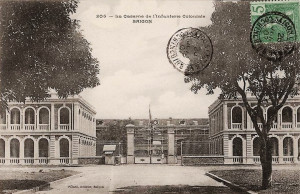
The infantry barracks built on the site of the old Citadel
The Citadel, the southern walls of which were razed, contains the “Martin Pallières” Barracks. This fortification, of the Vauban system, occupies the northeast corner of the earlier [1790] fortress, which was built by the Annamites during the reign of Gia Long to plans by the French military mission. It was demolished in 1835 following the revolt of the previous year, and replaced by the current Citadel.
The Military Hospital is formed of pavilions connected by large porches.
The Botanical and Zoological Gardens, created in 1864, is one of the most interesting parks in the Far East. It contains a bandstand for music. This “pleasure garden” incorporates a large aviary, animal pavilions and several greenhouses. In the latter, we may see beautiful collections of orchids and magnificent ornamental plants. The paths intersecting the green lawns of the park are lined with tropical flowerbeds. The aviary and pavilions are home to an endless variety of Indochinese birds and other fauna, including tigers, panthers, bears, elephants and snakes. The fields on the opposite bank of the arroyo-de-l’Avalanche [Thị Nghè creek] are annexed to the Agronomic Service.
The Naval Arsenal stands at the confluence of the arroyo-de-l’Avalanche and the Saigon river, on the site of the ancient Annamite shipyard. This property is the main base of the French fleet in the Far East and has an area of 22 hectares, including a 168m dry dock.
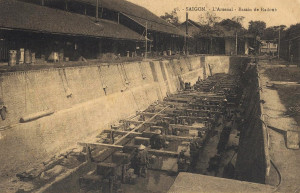
The dry dock
The workshops, forges and power-hammers here are used to perform major repairs and even to build torpedo boats. Its employees include 1,500 Annamite and Chinese workers under the supervision of specialist foremen. On the river, several warships are anchored.
Located along the quay towards rue Paul Blanchy [Hai Bà Trưng] (which runs parallel to rue Catinat) is the Admiralty, and beyond it the Rond-point [Mê Linh square], with its statue of Admiral Rigault-de-Genouilly (1807-1873) by sculptor Alexandre-Victor Lequien, and mausoleum of sailor and explorer Doudart-de-Lagrée (1823-1868).
Cholon
Cholon (pronounced Tioeu-leune and not Cho-len) is the “Big Market” (or big city). This is the commercial and industrial suburb of our Cochinchina capital. Its municipality has 181,640 inhabitants (1911), one-third of whom come from southern China. It is located at the confluence of Lo-Gom creek and the arroyo-Chinois and its importance dates from 1778 when Chinese traders settled there.
Three railways and four roads connect Saigon with Cholon.
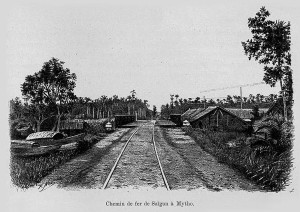
The Saigon-Mỹ-Tho railway line
The railways are: 1. The Saigon-My-Tho railway, first stop Cholon, journey time 9 minutes, price 40-60 cents; 2. The “High Road” tramway (5.1km), services every 20 minutes from 5.20am to 9.20pm and on Sundays up to 11pm, journey time 14 minutes, price 10 cents; and 3. The “Low Road” electric tramway (6.3km, extension to Binh Tây), services every 30 minutes from 5am to 8pm, journey time 28 minutes, price 8 cents.
The roads (average journey time 35 minutes) are as follows: 1. The “Route du Polygone,” an extension of the rue Legrand de la Liraye [Điện Biên Phủ], which passes the Racecourse and then crosses the huge “Plain of Tombs,” a vast necropolis covered by tumuli of brick or stone. 2. The “Route Stratégique,” an extension of the rue Chasseloup-Laubat [Nguyễn Thị Minh Khai] which cuts across the Saigon-My-Tho railway line. 3. The “Route Haute” (High Road), an extension of shady rue de Lagrandière [Lý Tự Trọng] which passes the pretty Cho Dui church (built in 1902) and the Camp des Mares, now assigned to the Annamite Riflemen but originally the location of Trung Hien-tu or Temple de la Fidélité éclatante (Temple of Bright Loyalty). The latter was built by King Gia Long (1802-1820) in memory of his mandarins and generals who helped to bring down the power of the Tay-Son (1789-1802). The loyal generals it honoured included a Frenchman named Man-oe (Manuel), commander of a royal squadron, who was killed in 1783 during a battle in Can-Gio harbour. He was described by Gia Long as a “Faithful subject, just and deserving” and was given the title “Leading general, column of the empire.” 4. The “Low Road,” which follows the arroyo-Chinois via Cho Quan (4km) to Cholon (6.3km).
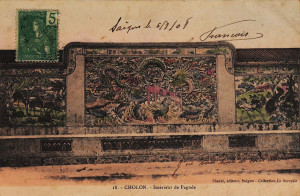
A decorative screen in one of Chợ Lớn’s assembly halls
A fifth road, a new 40m wide extension of boulevard Bonard, will eventually connect with the rue des Marins [Trần Hưng Đạo B] in Cholon.
All of Cholon’s commerce and industry is in the hands of the Chinese, grouped into five congregations according to their place of origin and language.
These congregations are: Kouang-Tong [Guǎngdōng] and the Si-Kiang [Xījiāng] Delta; Fou-Kien [Fújiàn], specifically Hok-lo [Hokkien or Min-nan] people from the area of E-moui (A-moi); Hak-ka (A-ka) from northeast Kouang-Tong [Guǎngdōng]; Trieu-Chau [Cháozhōu] from eastern Kouang-Tong [Guǎngdōng]; and Hai-Nam [Hǎinán], from the district of Wen-Tch’ang [Wénchāng] in the eastern part of Hainan island.
The curved bridges above the arroyos, the long signboards above each store, the Chinese lanterns which are lit as soon as the sun goes down, the crowds of people crammed into the streets or in the doorways of the theatres, all give this city a uniquely Asian stamp. Amble along the rue des Marins and the rue de Canton.
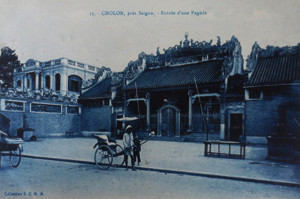
The Guǎngzhōu Assembly Hall
Some temples were raised by the various Chinese congregations to honour the saints or genies of their homelands; among these temples we may mention: those of Kouang-Tcheou [Guǎngzhōu] and Fou-Kien [Fujian], along with another one on the rue de Cây-mai which was reproduced in the Paris Exhibition of 1900. Also of note are the Collège franco-chinois and the city’s hospitals.
The Cây May (“Apricot Tree”) Pagoda was originally built by the Khmers as the Ho-Tang-Tran-Thap Pagoda, but in the 18th century the Annamites built the An-Tan Pagoda here in its place. It gets its current name from the apricot trees which were planted on the May-Ki hill. During the Tay-Son occupation of the south, the pagoda was damaged. When it was restored in 1814, a large quantity of ancient bricks and tiles was discovered, along with two gold tablets inscribed with the image of the Buddha seated on an elephant. Today, the pagoda is surrounded by extensive fortifications. Around it there is large-scale manufacturing of ceramics.
Surrounding areas
The “Tour de l’Inspection:” This 9km journey, taking 1 hour 20 minutes and travelling via the Botanical and Zoological Gardens, the pont de l’Avalanche, Phu-My, Gia-Dinh and Phu Nhuan, is the favorite promenade of the Saigonnais.
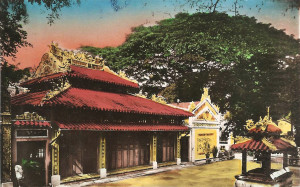
The tomb and temple of Marshal Lê Văn Duyệt
Reaching Bac-Lieu, capital of the province of Gia Dinh, visit the tomb of Le-Van-Duyet, the “Great Eunuch,” Kinh-Luoc (Viceroy) of Cochinchina during the reign of Minh Mang (1820-1841), who died in Saigon in 1832. This monument is one of the largest (24m by 10m) in the country. The temple is adjacent and contains interesting sculptures, weapons, costumes and the palanquin and ancestral tablets of Le-Van-Duyet.
In some difficult legal cases tried by indigenous courts there is still a tradition of “swearing an oath” in front of the altar of Le-Van-Duyet while drinking the blood of a freshly slaughtered chicken. In case of deception, this potentially submits the one who has uttered the oath, along with his family, to the wrath of the Eunuch.
The Tomb of the Bishop of Adran at Tan-Son-Nhut: A journey of 11km there and back, taking 2 hours, including the visit. The Tomb of the Bishop of Adran stands in a grove of beautiful mango trees. Monsignor Pigneau de Béhaine was the author of the 1787 treaty between France and Annam. He died near Qui-Nhon on 9 October 1799. The Prince Nguyen, soon to take the title of King Gia-Long (1802-1820), posthumously made him “Duke Bi-Nhu” (Pigneau). He also ordered the construction of this funeral monument in the style of Annamite temples and composed the epitaph which is engraved on his tomb. By a decree of 3 August 1861, the monument was declared French national heritage.
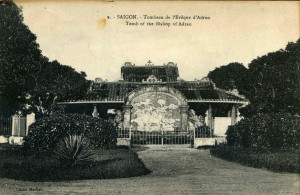
The tomb of the Bishop of Adran
Travel there via the third pont de l’Arroyo-de-l’Avalanche and the road to Go-Vap; then return via the route de Tong-keou, the canal de Ceinture and the Lignes de Chi-Hoa (an Annamite fortification destroyed in 1861 after a bloody struggle) and the arid Plain of Tombs.
Other places to visit: The column commemorating the battle of the Lignes de Chi-Hoa in 1861; the Annamite village of Phu Tho, created in 1747; the Kien Phuoc Temple; Phu Nhuan-(Binh-Hoa); the Thap-Phuoc Temple with its Buddhist pantheon.
Tim Doling is the author of the guidebook Exploring Saigon-Chợ Lớn – Vanishing heritage of Hồ Chí Minh City (Nhà Xuất Bản Thế Giới, Hà Nội, 2019)
A full index of all Tim’s blog articles since November 2013 is now available here.
Join the Facebook group pages Saigon-Chợ Lớn Then & Now to see historic photographs juxtaposed with new ones taken in the same locations, and Đài Quan sát Di sản Sài Gòn – Saigon Heritage Observatory for up-to-date information on conservation issues in Saigon and Chợ Lớn.
